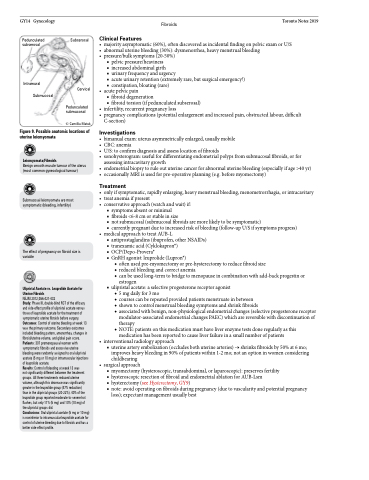Page 500 - TNFlipTest
P. 500
GY14 Gynecology
Fibroids Toronto Notes 2019
Pedunculated subserosal
Intramural Submucosal
Subserosal
Cervical
Pedunculated submucosal
© Camillia Matuk
Clinical Features
• majority asymptomatic (60%), often discovered as incidental finding on pelvic exam or U/S • abnormaluterinebleeding(30%):dysmenorrhea,heavymenstrualbleeding
• pressure/bulksymptoms(20-50%)
Figure 9. Possible anatomic locations of uterine leiomyomata
Leiomyomata/Fibroids
Benign smooth muscle tumour of the uterus (most common gynecological tumour)
Submucosal leiomyomata are most symptomatic (bleeding, infertility)
The effect of pregnancy on fibroid size is variable
Ulipristal Acetate vs. Leuprolide Acetate for Uterine Fibroids
NEJM 2012;366:421-432
Study: Phase III, double-blind RCT of the efficacy and side-effect profile of ulipristal acetate versus those of leuprolide acetate for the treatment of symptomatic uterine fibroids before surgery. Outcomes: Control of uterine bleeding at week 13 was the primary outcome. Secondary outcomes included bleeding pattern, amenorrhea, changes in fibroid/uterine volume, and global pain score. Patients: 307 premenopausal women with symptomatic fibroids and excessive uterine bleeding were randomly assigned to oral ulipristal acetate (5 mg or 10 mg) or intramuscular injections of leuprolide acetate.
Results: Control of bleeding at week 13 was
not significantly different between the treatment groups.Allthreetreatmentsreduceduterine volume,althoughthisdecreasewassignificantly greater in the leuprolide group (47% reduction)
than in the ulipristal groups (20-22%). 40% of the leuprolide group reported moderate-to-severe hot flashes, but only 11% (5 mg) and 10% (10 mg) of the ulipristal groups did.
Conclusions: Oral ulipristal acetate (5 mg or 10 mg) is noninferior to intramuscular leuprolide acetate for control of uterine bleeding due to fibroids and has a better side-effect profile.
• acutepelvicpain
■ fibroid degeneration
■ fibroid torsion (if pedunculated subserosal)
• infertility,recurrentpregnancyloss
• pregnancycomplications(potentialenlargementandincreasedpain,obstructedlabour,difficult
C-section)
Investigations
• bimanualexam:uterusasymmetricallyenlarged,usuallymobile
• CBC: anemia
• U/S:toconfirmdiagnosisandassesslocationoffibroids
• sonohysterogram:usefulfordifferentiatingendometrialpolypsfromsubmucosalfibroids,orfor
assessing intracavitary growth
• endometrialbiopsytoruleoututerinecancerforabnormaluterinebleeding(especiallyifage>40yr) • occasionallyMRIisusedforpre-operativeplanning(e.g.beforemyomectomy)
Treatment
• onlyifsymptomatic,rapidlyenlarging,heavymenstrualbleeding,menometrorrhagia,orintracavitary • treatanemiaifpresent
• conservativeapproach(watchandwait)if:
■ symptoms absent or minimal
■ fibroids <6-8 cm or stable in size
■ not submucosal (submucosal fibroids are more likely to be symptomatic)
■ currently pregnant due to increased risk of bleeding (follow-up U/S if symptoms progress)
• medicalapproachtotreatAUB-L
■ antiprostaglandins (ibuprofen, other NSAIDs) ■ tranexamic acid (Cyklokapron®)
■ OCP/Depo-Provera®
■ GnRH agonist: leuprolide (Lupron®)
◆ often used pre-myomectomy or pre-hysterectomy to reduce fibroid size
◆ reduced bleeding and correct anemia
◆ can be used long-term to bridge to menopause in combination with add-back progestin or
estrogen
■ ulipristal acetate: a selective progesterone receptor agonist
◆ 5mgdailyfor3mo
◆ courses can be repeated provided patients menstruate in between
◆ shown to control menstrual bleeding symptoms and shrink fibroids
◆ associated with benign, non-physiological endometrial changes (selective progesterone receptor
modulator-associated endometrial changes PAEC) which are reversible with discontinuation of
therapy
◆ NOTE: patients on this medication must have liver enzyme tests done regularly as this
medication has been reported to cause liver failure in a small number of patients • interventionalradiologyapproach
■ uterine artery embolization (occludes both uterine arteries) → shrinks fibroids by 50% at 6 mo; improves heavy bleeding in 90% of patients within 1-2 mo; not an option in women considering childbearing
• surgicalapproach
■ myomectomy (hysteroscopic, transabdominal, or laparoscopic): preserves fertility
■ hysteroscopicresectionoffibroidandendometrialablationforAUB-Lsm
■ hysterectomy(seeHysterectomy,GY9)
■ note: avoid operating on fibroids during pregnancy (due to vascularity and potential pregnancy
loss); expectant management usually best
■ pelvic pressure/heaviness
■ increased abdominal girth
■ urinary frequency and urgency
■ acute urinary retention (extremely rare, but surgical emergency!) ■ constipation, bloating (rare)


